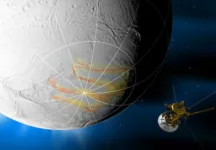Since Cassini photographed geysers of water vapor and icy particles at Enceladus’s south pole, scientists have suspected subsurface waters on the moon. Following these observations, scientists promptly produced models to explain how the 500km-wide satellite could maintain liquid water, suggesting the existence of a small lake or sea.
After years of studying pictures sent back from the Cassini probe, scientists have observed a slight wobble in the moon, the magnitude of this flutter leads to the conclusion that the ice cluster, covering Enceladus, is not connected to the core, and most probably floating on a global ocean of liquid water.

Considering that salts and organic molecules have also been detected, Enceladus could be a habitable world. Scientists are fascinated and curious to learn more but it can take decades before they can start a dedicated mission.








